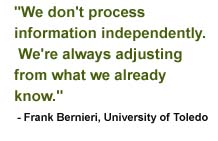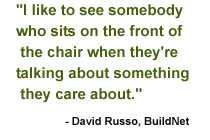|
A good first impression
|
 |
September 1, 2000: 7:57 a.m. ET
Subtle factors influence you from the moment you meet someone in business
By Staff Writer Steve Bills
|
NEW YORK (CNNfn) - When the candidate walked in the door for the job interview, Jordan Duggan felt a twinge.
On the phone, the job applicant had sounded like a 35-year-old professional, smooth and mature. "He gave a fantastic phone interview. His portfolio was immaculate," recalled Duggan, the creative director of Indicium Design, a small presentation-production house in Raleigh, N.C. "When I saw him, he was like a 25-year-old used car salesman."
Still, he seemed knowledgeable about the software that the company used to generate its interactive presentations for sales people and the Web, and such professionals are hard to find. Said Duggan: "If he truly was the person he was claiming to be, I was willing to take a risk."
Alas, within a few days, the new employee's technical shortcomings soon became apparent, and a subsequent background check showed that the man was not responsible for all the good projects he took credit for. He was soon gone from the company.
"We've since changed our policies, because of this individual," Duggan said. Background checks are more intensive, and Indicium now asks applicants to do a live demonstration of their skills with presentation software such as Flash. "It was definitely a learning experience."
Acting on insufficient information
Yes, you can fake it in a job interview setting, and yes, it might even work to get you the job. But as psychologists, sociologists and personnel experts point out, the relationships between people are tremendously complex, involving a great number of assumptions based on insufficient information.
 The impressions formed in the first moments are likely to color the relationship from that point forward. The impressions formed in the first moments are likely to color the relationship from that point forward.
"There's a snowball effect," said Frank Bernieri, a psychologist at the University of Toledo, Ohio. "We don't process information independently. We're always adjusting from what we already know."
Still, people seem to have an uncanny knack of sizing up those they meet in an instantaneous flash of recognition. Bernieri described one experiment that used video clips from staged job interviews on campus. The student researcher showed the introductory moments from each interview to 30 "naïve observers," asking them to rate the job candidates on a range of qualities including intelligence, competence, interpersonal warmth, politeness.
The collective results, based on 15-second clips of the "greeting and seating," showed an eerie correspondence to the ratings given by the actual interviewers after 20-minute conversations.
"Just that first impact must have influenced the interviewers' impression," Bernieri suggested.
But it also could be that the observers were picking up on something subtle but real. The interviews that the video clips were culled from involved a different social experiment, studying a phenomenon called mimicry.
Adopting similar mannerisms
It is commonly accepted that people who are in rapport will adopt similar body language -- fold their arms or legs the same way, employ similar gestures, pick up one another's voice mannerisms. In these staged job interviews, half the candidates were coached to subtly mimic their interviewers.
It didn't work. Only one interviewer picked up on the candidates' gambit, and was angered by it, he said: "Once you do become aware of it, it becomes very aversive, because it is offensive to the target."
But the effort interfered in other ways. For instance, the job applicants had a hard time answering questions, Bernieri said: "It's difficult coming up with good answers to questions when you're focusing on nonverbal communications."
It also didn't affect the outcomes. The only time mimicry was effective was when it came naturally, he said: "It's like acting, telling somebody to be more expressive by pounding the podium. It's probably beyond our control."
Value of a firm handshake
Another experiment along similar lines involved the act of shaking hands. In this student-led research, conducted at the University of Alabama, the strength and duration of that handshake corresponded to a favorable first impression.
"Men tended to have a firmer handshake than women on average," said William Chaplin, the psychologist who oversaw the research, "but women who had a firm handshake made as good an impression as men."
 Chaplin also expressed doubt that you could succeed by faking it. For a person who is shy or insecure, "it's going to be difficult to overcome that and give the firm, vigorous, look-'em-in-the-eye handshake that makes the best impression." Chaplin also expressed doubt that you could succeed by faking it. For a person who is shy or insecure, "it's going to be difficult to overcome that and give the firm, vigorous, look-'em-in-the-eye handshake that makes the best impression."
And although he warned that he had not studied this point, he ventured the suspicion that a shy person trained to give a firm handshake might in fact make a worse first impression, if other aspects of body language did not match up.
Practitioners in the personnel field say other indicators are more important. "It would be nice if everybody had a nice firm handshake, without a vice grip, without a limp wrist, but I don't think the handshake is that important," said David Russo, executive vice president of BuildNet, a business-to-business Web site serving the construction industry. "I've learned to get over that."
A sense of enthusiasm
What Russo looks for is a sense of enthusiasm: "I like to see somebody who sits on the front of the chair when they're talking about something they care about."
He recalled the advice of an old mentor, who told him, "When you're talking to somebody, look for the light behind their eyes." He added, "Those are the people you want working for you, the people you want developing your software and building your products."
In today's tight job market, such candidates can be hard to find. "Here in the Research Triangle (of North Carolina), if your breath makes a smudge on a mirror, you can get a job," Russo acknowledged. Thus, more organizations are doing background checks and resume checks to guard against job seekers who try "getting by with guile rather than application of talent." 
|
|
|
|
|
 |

|

